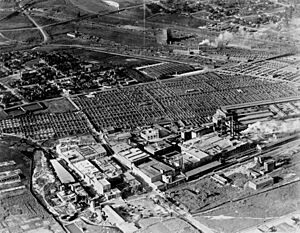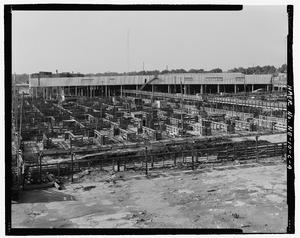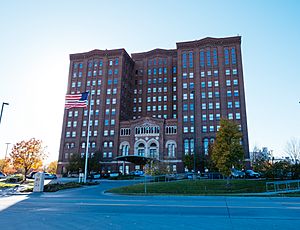Union Stockyards (Omaha) facts for kids
The Union Stockyards in Omaha, Nebraska, was once a huge market where farm animals were bought and sold. It started in 1883 in a part of Omaha called South Omaha. For many years, it was one of the biggest livestock markets in the United States.
By 1890, the Omaha Stockyards was the third largest in the country. In 1947, it was the second largest in the world, right after Chicago. Then, in 1955, Omaha became the number one place for selling livestock and processing meat in the nation. It held this important title until 1971. After 116 years, the Union Stockyards closed its doors in 1999. The main office building, called the Livestock Exchange Building, is now a historic landmark.
Contents
A Look Back: The Stockyards' Story
Before the Stockyards even began, the first meat packer in Omaha was James E. Boyd. He was an important politician who started a meat processing business in downtown Omaha. Later, in the early 1880s, a cattle rancher named Alexander Swan suggested building a new, bigger facility. He worked with people like William A. Paxton, Herman Kountze, and John A. Creighton to make it happen.
The new stockyards received their first group of 531 longhorn cattle in 1884. At first, the Union Stockyards was mainly a place where animals could rest and eat. This was before they continued their journey to markets further east, like the famous Chicago Stock Yards. The very first office for trading was in a farmhouse on the site. The Union Stockyards was huge, covering over 260 acres (about 1 square kilometer) of land. Nearly 200 acres (about 0.8 square kilometers) were filled with pens for animals.
In 1885, a much larger office building was built. It was called the second exchange building. This impressive building had many features, including apartments for traders and fancy rooms for meetings. This showed how important the livestock business was becoming in Omaha. During this time, four major meatpacking companies set up shop: Armour, Wilson, Cudahy, and Swift. These companies were known as the "Big Four."
Growth and Busy Times (1900-1940s)
Around 1900, the Stockyards got even better. They added new pens with brick floors and concrete water troughs. They also installed new scales to weigh the animals. The sheep barn was rebuilt to hold an amazing 100,000 animals! A new, two-block long barn for horses and mules was built, too. People called it "the largest and best single barn in the world." It became the biggest market for ranch horses anywhere.
By 1910, about 20,000 animals arrived at the Stockyards every single day. These animals came from farms and ranches in 20 different states. Ten large slaughterhouses and meatpacking plants were busy working nearby. Between 1907 and 1910, many of the old pens were updated. New walkways were added so buyers could see the animals easily without walking through the pens. In the early 1900s, the Union Stockyards was the world's largest market for sheep.
The stockyards relied heavily on railroads, especially the Union Pacific Railroad, to bring animals to market. On average, 20,000 animals arrived daily for processing. Cattle, hogs, sheep, horses, mules, and even chickens were sold there. By 1888, the "Big Four" packing companies were processing over 1 million cattle, hogs, and sheep each year. By 1892, these meatpacking plants employed 5,000 people in the area known as "Packingtown." In 1897, Armour's plant in South Omaha was the largest in the entire country. The meatpacking industry and the Stockyards were vital for South Omaha's growth for over 100 years.
Omaha's Peak as a Livestock Hub (1950s-1970s)
In 1955, Omaha was a unique city. It was the only place in the world where all four of the "Big Four" companies—Armour, Swift, Cudahy, and Wilson—processed cattle, pigs, and sheep. That same year, Omaha officially became the nation's largest livestock market and meatpacking center. It held this top spot until 1973.
The workers in the meatpacking industry were organized into unions. This helped them earn good wages and live a comfortable middle-class life. These unions were also important because they included workers of all races and supported the Civil Rights Movement in the 1960s. In 1957, it was estimated that half of all workers in Omaha were employed in jobs related to the stockyards. The local Chamber of Commerce even said, "Livestock is Omaha’s lifeblood." By 1959, the Omaha World-Herald newspaper called the industry "the backbone of Omaha's economy."
The Stockyards' Closing and New Beginnings
In the 1960s, the Stockyards started to face challenges. Changes in the market and the meatpacking industry meant less business. In 1973, the Union Stockyards Company was sold. Companies like IBP began to build new slaughterhouses closer to where cattle were raised in rural areas. These new plants often hired workers who were not part of a union.
Trading at the Omaha Stockyards became focused on the Livestock Exchange Building. In 1997, the Stockyards processed 197,575 animals. In 1989, a company from Minneapolis bought the livestock operations. However, the facilities began to fall apart. In 1996, the City of Omaha bought 50 acres (about 200,000 square meters) of land for a new office park. The city decided to close down most of the old stockyards, except for the Livestock Exchange Building, which was planned for repair.
New Life for the Old Stockyards Area
Today, the area where the Union Stockyards once stood is being redeveloped. It is now called the Stockyards Historic District. This project includes a new campus for the Metropolitan Community College in South Omaha. The historic Livestock Exchange Building has been updated. It now has over 100 apartments, community spaces, and businesses. The City of Omaha also worked with the college to build a new home for the South Omaha Library in the area.
See also




